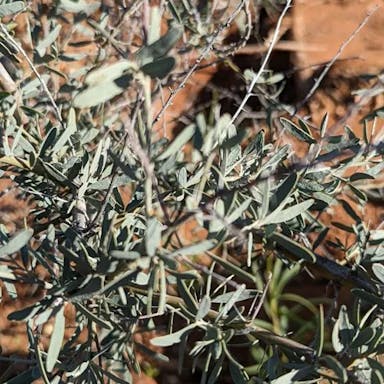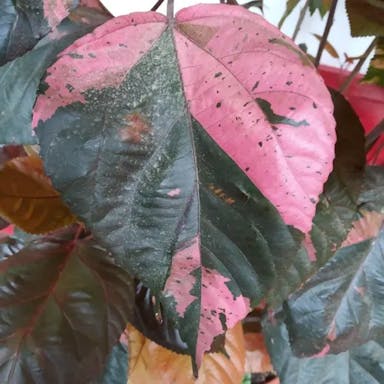Blackbrush, scientifically known as Coleogyne ramosissima, is a plant that belongs to the Rosaceae family. Everyone would like this tightly twiggy plant. It has lush foliage. This plant thrives in dry conditions. It has dainty white flowers. This plant has airy branches which seem to dance in the wind. This is greatly valued in gardens in dry regions. Overall, this is a pretty plant that can handle the heat.
Blackbrush
- Scientific name
- Coleogyne ramosissima
Basic Information
- Rosaceae Family Coleogyne Genus Blackbrush Species
- Rosaceae > Coleogyne > Coleogyne ramosissima
- 83%
- The Completeness of This Encyclopedia
Please help us complete the encyclopedia, Terrarium is a encyclopedia service to be completed with everyone in the world. Currently, this page is 83% complete. For more information on how to contribute, please click here.
- Shrub
- Height
- 100cm ~
- Flower Color
- Leaf Color
- Anthesis
- spring
- Sunlight Exposure
Full Sun Long hours of sunlight from morning to afternoon Partial Shade A location in the shade of a tree or where either the morning or afternoon is shaded Full Shade A place where there is no direct sunlight
- Full Sun
- Hardiness Zones
This is an indicator to know to which zone each plant can winter. Knowing the zone of each plant gives you an idea of the cold temperature resistance when grown in the ground without a roof. 2: -42.7 to -40.0 3: -39.9 to -34.4 4: -34.3 to -28.9 5: -28.8 to -23.3 6: -23.2 to -17.8 7: -17.7 to -12.2 8: -12.1 to -6.7 9: -6.6 to -1.1 10: -1.0 to 4.4 11: 4.5 to 10.0
- 7
- Cold resistance
- Excellent
- Heat resistance
- Good
- Habitat of origin
- United States
- Growth Rate
- Slow
What is Blackbrush (Coleogyne ramosissima)?
What is Blackbrush (Coleogyne ramosissima)
Flower meaning
The meaning associated with the plant Blackbrush in American flower language is as follows: - Blackbrush is linked to staying power and flexibility. - It represents inner strength when dealing with problems. - Blackbrush also suggests adapting well and prospering in unfavorable conditions. - It is frequently related to determination and conquering tests. Roses are a typical example of flower language. Roses usually mean love and affection. Red roses, especially, mean deep passion and desire. They are frequently given to express fondness and are popular on Valentine's Day. Roses can also have other meanings depending on their color. For instance, yellow roses mean friendship and joy, while white roses represent innocence. Keep in mind flower language can differ based on cultural and historical background.
Calendar of Blackbrush (Coleogyne ramosissima)
Calendar
The arid areas of the southwestern United States are home to a native plant called Blackbrush. Its scientific name is Coleogyne ramosissima. From late spring until early summer, this plant blooms. Its peak bloom time is in May. For about 2-3 weeks, the blooming period lasts. Small white or pale yellow flowers that cluster together are produced by the plant during this time. To make the blooming period longer, giving the plant sufficient sunlight and well-drained soil is crucial. Also, spent flowers should be removed and regular pruning done to help continuous blooming occur. Blackbrush is an important desert plant. It gives food and habitat to various wildlife.
How to grow Blackbrush (Coleogyne ramosissima)
Watering
Blackbrush, scientifically known as Coleogyne ramosissima, requires a specific watering regimen to thrive. Watering Blackbrush every 2-3 weeks during spring to fall growing season, with sufficient water to moisten the soil 6-8 inches deep, is recommended. However, overwatering can cause issues. In winter, significantly less water is required - once every 4-6 weeks, allowing soil to dry out between waterings, mimics natural habitat conditions. Monitoring soil moisture using meter or by hand to check if dry or moist helps determine optimal frequency. Following these guidelines allows Blackbrush to thrive.
Soil and Fertilizer
Desert regions host Blackbrush, its scientific identity Coleogyne ramosissima. Sandy or gravel-like soil textures suit it ideally when drainage excels. Ideal pH levels for Blackbrush live between 7.0 and 8.5. Note that low-nutrient soils suit it, so avoid fertilizers unless soils lack nutrients clearly. When essential, carefully apply balanced slow-release fertilizers during spring or autumn. Base fertilizer amounts on soil tests and the plant's needs. Check soils regularly to enable ideal plant health.
Sunlight and Place
Blackbrush, known as Coleogyne ramosissima, grows in dry areas with sunlight. It can handle cold and heat, so it is good for many temperatures. But very cold and hot temperatures below freezing or above 100°F may hurt it. In summer, Blackbrush can take strong sun and heat. But some shade during the hottest time of day helps it. For winter, it is tough and can handle freezing. But it may need protection from very cold for a long time. Blackbrush should go in a spot that gets full sun most of the day. It needs at least 6-8 hours of direct sunlight to grow well. In summary, Blackbrush handles many temperatures and needs lots of sun to grow best.
Advanced Information of Blackbrush (Coleogyne ramosissima)
Pruning
Blackbrush, scientifically known as Coleogyne ramosissima, is a shrub with growth patterns. For maintenance and shaping purposes, reduction of growth and parts is required. At the beginning of the plant's dormant period, when buds are still closed, is the optimal season for trimming. Allowing recovery before active growth resumes improves plant vigor. Remove damaged, diseased, tangled, and rubbing branches. Clean, sharp cutters should sever branches just beyond a bud or branch junction, angling away from the bud. Avoid wounding the main stem. After finishing, disinfect tools to prevent spread of pathogens. Apply an organic mulch layer around the base, and provide adequate moisture and balanced nutrition to aid recovery.
Planting and Harvest
Blackbrush, scientifically knows Coleogyne ramosissima, be plant able pot or plant ground. When pot Blackbrush, important choose container large enough accommodate plant root system. Pot should have drainage holes prevent waterlogging. To pot Blackbrush, start fill container well-draining potting mix. Gently remove plant current container, careful not damage roots. Place plant center pot fill remaining space potting mix, ensuring plant same level previous container. Water plant thoroughly after potting place location receives full sun. Blackbrush prefers dry conditions, important allow soil dry out between waterings. Fertilize plant sparingly, excessive nutrients detrimental growth. If plant outgrows pot, may need repotted. This typically done every 2-3 years. To repot Blackbrush, follow same procedure potting, choose larger container. Mishowing, improper care, lead decline Blackbrush. Overwatering, lack sunlight, excessive fertilization should avoided. Additionally, Blackbrush susceptible certain pests diseases, regular monitoring appropriate treatment necessary.
Propagation
Separation into stems is one process of Blackbrush proliferation. Leaf removal can assist root system production. Seeds meant for forthcoming use may be obtained upon maturity. Another means of increasing numbers includes partitioning an established organism. Cut portions ought to have connecting plant matter channels. Transplanting new entities to soil enables continued development. Yet another technique requires cutting stems bearing a minimum of two protrusions. Apply material prompting below ground elements prior to planting cuttings shallowly in appropriate matter. Retain dampness while permitting oblique brightness until fresh individuals materialize. Leaf bases plunged in draining mixture generate new plants when kept moist under protection. Collecting takes place once clones attain transplanting stature or once seeds are gathered.
Pests and Diseases
Blackbrush (Coleogyne ramosissima) is susceptible to several pests and diseases. A common pest that affects Blackbrush is the Blackbrush psyllid (Trioza coleogyne). This insect feeds on the plant's leaves, curling them yellow. Infestations weaken the plant. Prevention includes regular monitoring and early detection. If necessary, insecticidal soaps or oils can control the population. Another pest is the Blackbrush beetle (Moneilema sp.). These beetles feed on the stems, damaging the plant. To prevent infestation, maintain plant health. Pruning and removing dead or damaged branches helps reduce risk. As for diseases, Blackbrush gets root rot from Phytophthora spp. This fungus attacks the roots, withering the plant. Prevent root rot by ensuring drainage, avoiding overwatering. Plant in well-drained soil. Provide air circulation. In summary, Blackbrush is susceptible to pests like the psyllid and beetle, and root rot. Monitoring, early detection, and proper care prevent and manage issues.
Habitat of Blackbrush (Coleogyne ramosissima)
Habitat
Toxicity of Blackbrush (Coleogyne ramosissima)
Health Benefits
- edible
- Inedible
- Toxic
- No toxicity
NO DATA
Toxic for dogs and cats
NO DATA
Q&A of Blackbrush (Coleogyne ramosissima)
- Is there a recommended way to choose Blackbrush?
Blackbrush, scientifically known as Coleogyne ramosissima, is a native plant to the southwestern part of the United States. Picking the right kind of Blackbrush is significant when thinking about how well it will grow in the weather and soil where you live. Some kinds can handle drought or cold better than others. Buy seeds that are not old and will sprout. Check the date on the package. Also make sure the seeds look good, not ruined or discolored. Get seeds from sellers you trust so you know the seeds are good quality. If you want to buy baby Blackbrush plants instead of seeds, choose ones that are strong and healthy. Look for plants that have good root systems and sturdy stems. Stay away from plants with signs of bugs or disease. Overall, finding the right kind, seeds, or baby plants of Blackbrush is key for growing it well. Think about how each kind grows best and pick the one that will do well in your area's weather and soil.











